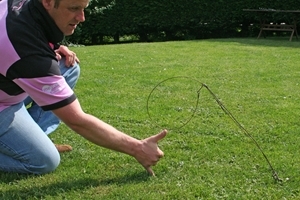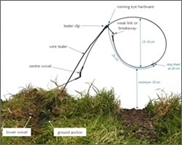How To Set A Snare
Grooming
Ideally your snares should be prepared in such a way that they require minimal handling to set them upwards. Merely prick in the tealer, attach the snare to the anchor, make concluding adjustments and go out. We colour our snares in bundles temporarily fastened with wire, which avoids them tangling during transport. The more yous handle snares betwixt boiling and setting them, the greater the risk of the play tricks detecting the snare.
Peak and dimensions
 A snare loop measuring 9" beyond by 6" deep (23x15cm) is almost right for nigh circumstances – a larger loop requires less accuracy in placement but is heavy and floppy, and is more likely to catch non-targets. On level ground, the bottom of a loop this size needs to be nigh 7-7½" (18-19cm) in a higher place the ground. On banks this height should be increased considering the flim-flam will unremarkably hold its head upwards to look alee, not at its anxiety. You could too increase the loop size slightly in these circumstances to make up for the loss of accuracy. Where badgers are common, the adventure of communicable them can be reduced by increasing the height of the loop to viii" (20cm) or more above the ground (BASC recommend 9"/23cm). This volition have a pocket-size negative impact on your fox capture rate.
A snare loop measuring 9" beyond by 6" deep (23x15cm) is almost right for nigh circumstances – a larger loop requires less accuracy in placement but is heavy and floppy, and is more likely to catch non-targets. On level ground, the bottom of a loop this size needs to be nigh 7-7½" (18-19cm) in a higher place the ground. On banks this height should be increased considering the flim-flam will unremarkably hold its head upwards to look alee, not at its anxiety. You could too increase the loop size slightly in these circumstances to make up for the loss of accuracy. Where badgers are common, the adventure of communicable them can be reduced by increasing the height of the loop to viii" (20cm) or more above the ground (BASC recommend 9"/23cm). This volition have a pocket-size negative impact on your fox capture rate.
Plant your wire tealer at a slight incline, to i side of the run. Now anchor the hinge cease of the snare earlier you lot forget, and before making fine adjustments. If necessary, bend the tealer slightly to allow the snare loop to form a natural-looking bend at the right height. If the loop is floppy, y'all may usefully add
a 2d tealer of fine florists' 'stalk' wire (the uncoated, very malleable stuff) on the opposite side of the run. Prick this lightly into the footing, but just just enough to support the loop, or it will interfere with loop closure. Finally adjust surrounding vegetation to look undisturbed and to disguise the outline of the snare loop. Nosotros often like to gear up the snare beside a long grass stalk, which we utilize to disguise the snare outline.
Some operators prefer to hang the noose from a longer tealer which arches slightly over the run, so that the centre is quite high (well-nigh 11 o'clock or one o'clock, taking the snare loop every bit a clock face). This makes the snare 'go off ' like a trap, the noose closing at a light touch nether the weight of the cable and running heart. This sensitivity can be a nuisance though: a passing deer or fifty-fifty a breeze may crusade the noose to drib and hang at that place, partially closed and appreciably lower than originally set. In this land information technology will not take hold of the flim-flam, but it may take hold of a badger. The other arroyo is to have the noose emerge from the top of the tealer, so that the eye is at one side of the noose (ie. 3 o'clock or ix o'clock–ish; the precise position will depend on how soft or self-supporting the cable is.). The top of the tealer will require a slight bend to make it grade naturally into the curve of the noose. A snare fix similar this needs a more prolonged tug to brand information technology depict upwards.
Footwork
While you are setting the snare, stand or crouch in the run itself, but endeavor non to broaden it. Do not stand to one side of the run, as a play a joke on volition also diverge from the run to see what you did there, thereby missing the snare. Yous tin put a snare on a rails fifty-fifty if you must walk there daily. If you practice this, place your feet along the runway just close upwardly to the snare on both sides. This keeps the track trodden. If you regularly take a wide pace over the snare, foxes besides will leap over information technology. On no account walk round the snare, even when setting it. Foxes have a trend to follow the easiest path, and then if the run is particularly wide, such as forth a field border, use pocket-sized stones and twigs to subtly guide the fob towards the noose.
Scent
Attention to scent helps enormously. We recommend that you set snares in the morning and then that whatsoever human odour left on the snare, or at the snare set, has the greatest chance of dissipating before nightfall. Proceed water and scent-free soap in your vehicle and wash your easily thoroughly when you first arrive at your snaring site. Before handling or setting snares, but well away from your offset snare site, rub your hands with freshly exposed soil (merely not from somewhere a fox may have peed, such equally a molehill!). This will help to prevent your scent getting onto the snare or surrounding vegetation. To minimise scent, wear rubber boots when setting snares, and keep them clean. Do not kneel in the run when setting the snare - crouch only. Your scent is readily transferred from your trouser knees to the basis, just not from rubber boots. You may find all this concern about scent tedious. We regard it as essential.
Go your Costless fox snaring guide from the GWCT team
Only enter your email address below to download your essential free guide.
 What's inside your Costless play a joke on snaring guide
What's inside your Costless play a joke on snaring guide
✓ Pull a fast one on command: Is it important?
✓ What are the alternatives to snaring?
✓ The principal components of a well-designed snare
✓ Play tricks snares: Hardware vs do
✓ Central controversies
Download free >
Source: https://www.gwct.org.uk/advisory/guides/fox-snaring-guidelines/how-to-set-a-snare/

0 Response to "How To Set A Snare"
Post a Comment